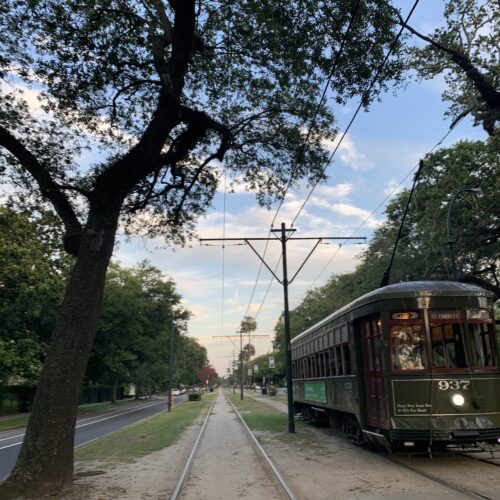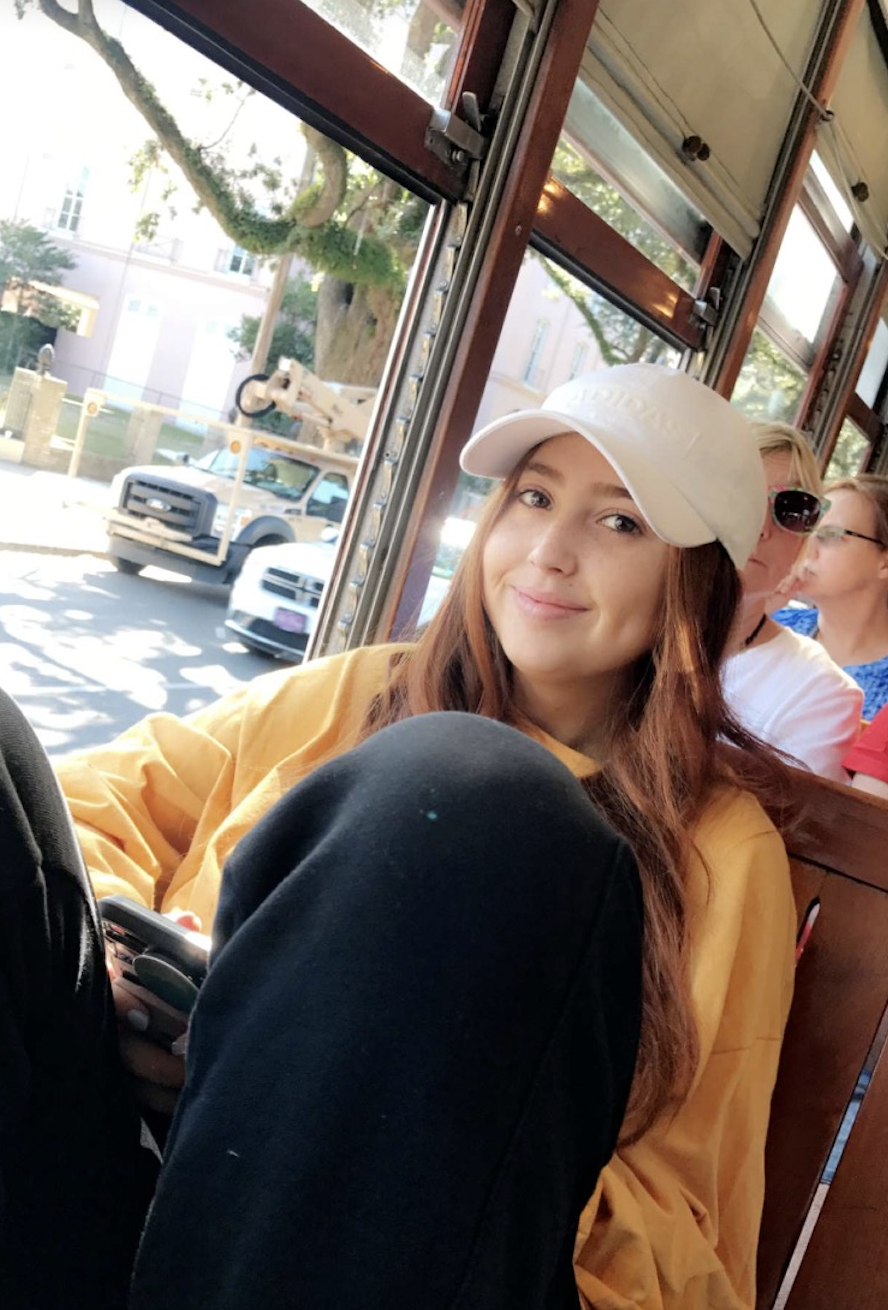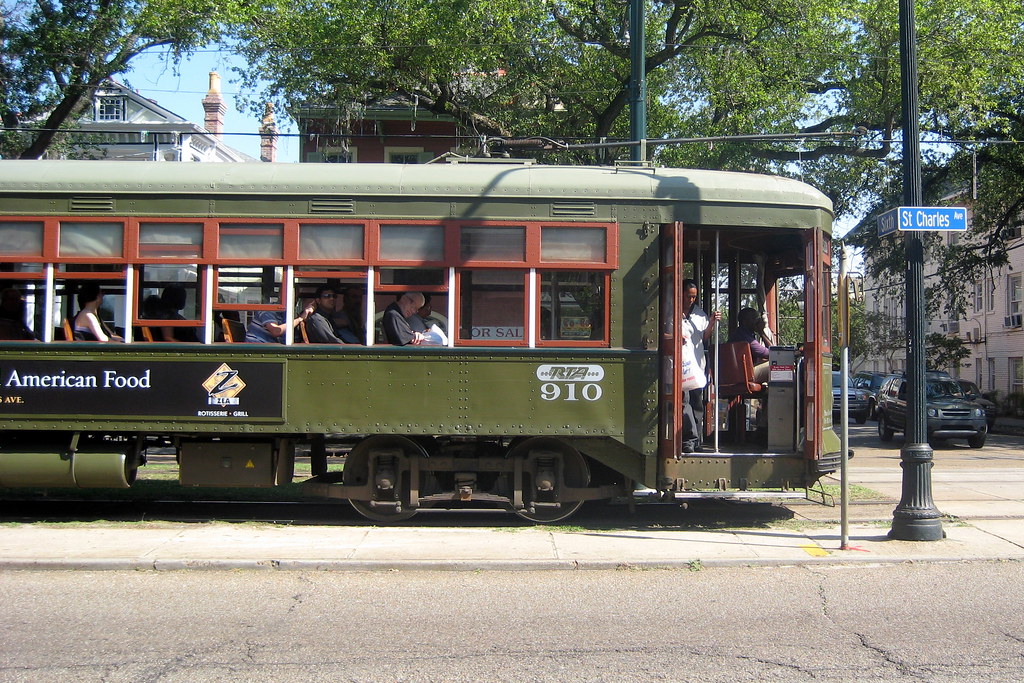Congrats, you have finally arrived in New Orleans! You have been dreaming of walking the streets of the French Quarter, sitting in a jazz club on Frenchman Street, and of course, taking a ride on a streetcar.

New Orleans St. Charles streetcar line. (Photo by: Blake Katz)
So, why are you so excited to ride on the streetcar?
Is it because it’s a nice day out?
Are the Ubers too expensive? ($20 for a one-mile trip)
Do you want to take Instagram pictures?

Tulane University student Amanda Rosenberg on a New Orleans streetcar. (Photo by: Blake Katz)
Or, is it something you just have to do…you’re in New Orleans after all!
Despite three streetcar lines running 24/7 with over 19 million rides each year, being constantly pictured on postcards sold on Bourbon Street, and referenced in my favorite song, “StreetCar” by Daniel Caesar, many people know very little about the history of the famous New Orleans streetcar. I mean, when was the last time you asked your Amazon Alexa when the streetcar was founded, or better yet why the streetcar was founded?
My point exactly.
So let’s take a quick streetcar ride through history together. Don’t worry—I promise you will still have enough time to snap pictures for your New Orleans Instagram highlight.
Let’s start with the reason WHY people use streetcars. Believe it or not people…used…them…as…their…main…form…of…transportation.
Crazy.
I know.
No Ubers?
Insanity.
Okay, so now that you have had a moment to take that in, picture your great-grandparents chilling on the streetcar, watching a milkman deliver milk to people’s front doorsteps.
Oh wait, your great-grandparents were Black? No no no, they were not on this streetcar, this is the whites-only streetcar. Black Americans were forced to ride the “star cars.” The star cars were not as lavish as the whites-only cars and were often overcrowded. Usually only running as the third or fourth car, these star cars ran infrequently and were harder to catch a ride on.
You probably know a little about Rosa Parks and the organizing that led to the abolition of Jim Crow laws, but do you know how much New Orleanians had to go through for equal streetcar rights?
Yes, equal streetcar rights.
The fact is, the streetcar we all get to love and enjoy today (for $1.25), we did not all get to love and enjoy in the late 1800s. Streetcars were just another realm in which white Americans had more privilege.
Picture This: You are riding the Black star car, and you see a large group of white gang members watching the whites-only car pass by just so they can instead hop on the star car. They squeeze their way through crowds of people uncomfortably squished next to each other before humiliating the Black men riding in peace. Soon, they harass the Black women minding their own business. I know this probably sounds nothing like the streetcar you rode the other night, but this is what riding a star car was like in 1866.
Now, it is 1867. A year has gone by and Black Americans are still forced to ride the star cars. But, April 28 is different. William Nichols, an equal rights activist, decides he is done taking this $#!+ and hops on a whites-only car.
As you probably guessed, the streetcar driver and passengers are livid. But, does Nichols care?
Of course not.
He refuses to step out of the car until the driver physically pushes him off and he is arrested for boarding a car “set apart for the exclusive right of white persons.”
So, did this settle the streetcar drama?
Not exactly.
The charges against Nichols are dropped and the streetcar drivers decide they cannot physically push Black Americans off the whites-only cars anymore. Instead, they agree that each time an African American tries to ride a whites-only car, the drivers will just hit the breaks and remain motionless until the Black passenger steps off.
Progress?
Not really.
A week goes by. As you can guess, African Americans are less than happy. In response, many Black citizens organized to hop on whites-only streetcars around the city to protest for equal rights.
The streetcar drivers refuse to start driving, and African Americans refuse to hop off. Hours pass, and the streetcars are still sitting in place. The Black passengers are not backing down.
It is now May 5, 1867. The city is pure chaos. People are getting ready to fight and many are expecting the worst. 500 people gather in front of Congo Square waiting to see what the police had in store for the Black citizens.
Blowing everyone’s minds, the chief of police says, “Have no interference with negroes riding in cars of any kind…..No passenger, has a right to eject any other passenger, no matter what his color.”
*Cue the applause*
The Black protestors were successful. They peacefully secured equal streetcar rights, concluding the 1867 streetcar protests.
Fast forward to November 11, 2020. It is noon on a Sunday. We wait for the streetcar to make a horrifyingly loud screeching noise while it stops in front of us. We walk up the steps and put the exact change in the meter. We walk to our seats. We scroll through TikTok as we listen to the couple bicker behind us. We enjoy the fresh New Orleans air and pull the lever to get off at Audubon Park.

A St. Charles Streetcar. (Photo by: Wallyg)
We just got on and off a streetcar without once thinking about the fact that this action is a right that Black New Orleanians had to fight for. We can enjoy our casual streetcar ride from downtown to uptown with our only worry being not having the exact change.
So, the next time you step onto a New Orleans streetcar, maybe take a minute to think about William Nichols and all the other activists who refused to be denied streetcar rights. They demanded peace and civil rights on a streetcar full of inequality and discrimination.
They are legends.
This piece was edited by Lily Plowden as part of Professor Kelley Crawford’s Digital Civic Engagement course at Tulane University.
 NOLAbeings
Multimedia artist Claire Bangser created NOLAbeings as a portrait-based story project that marries...
NOLAbeings
Multimedia artist Claire Bangser created NOLAbeings as a portrait-based story project that marries...
 Data corner: Adobe Suite (create a PDF, social media graphic, presentation, edit a photo and video
Data corner is where you go to work with analytics and top tech skills. It takes on everything from PERL and SQL to Canva and Sprout Social.
Data corner: Adobe Suite (create a PDF, social media graphic, presentation, edit a photo and video
Data corner is where you go to work with analytics and top tech skills. It takes on everything from PERL and SQL to Canva and Sprout Social.

Loved reading this! Your way of presenting information is clear and engaging. I also want to suggest you Cyber Security details